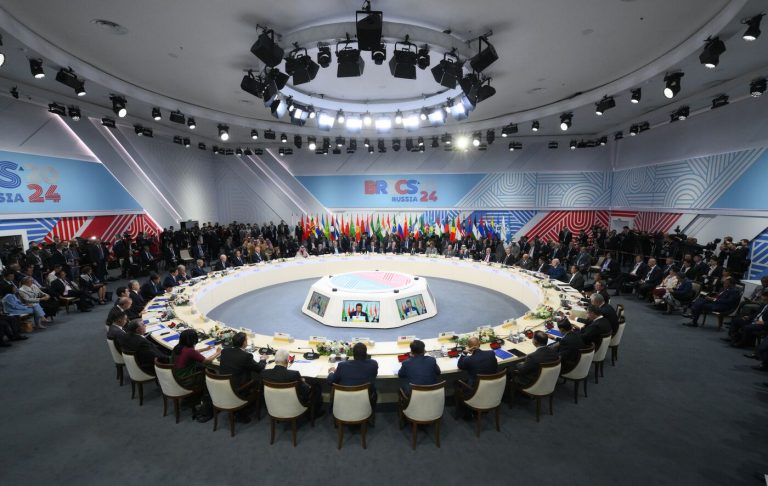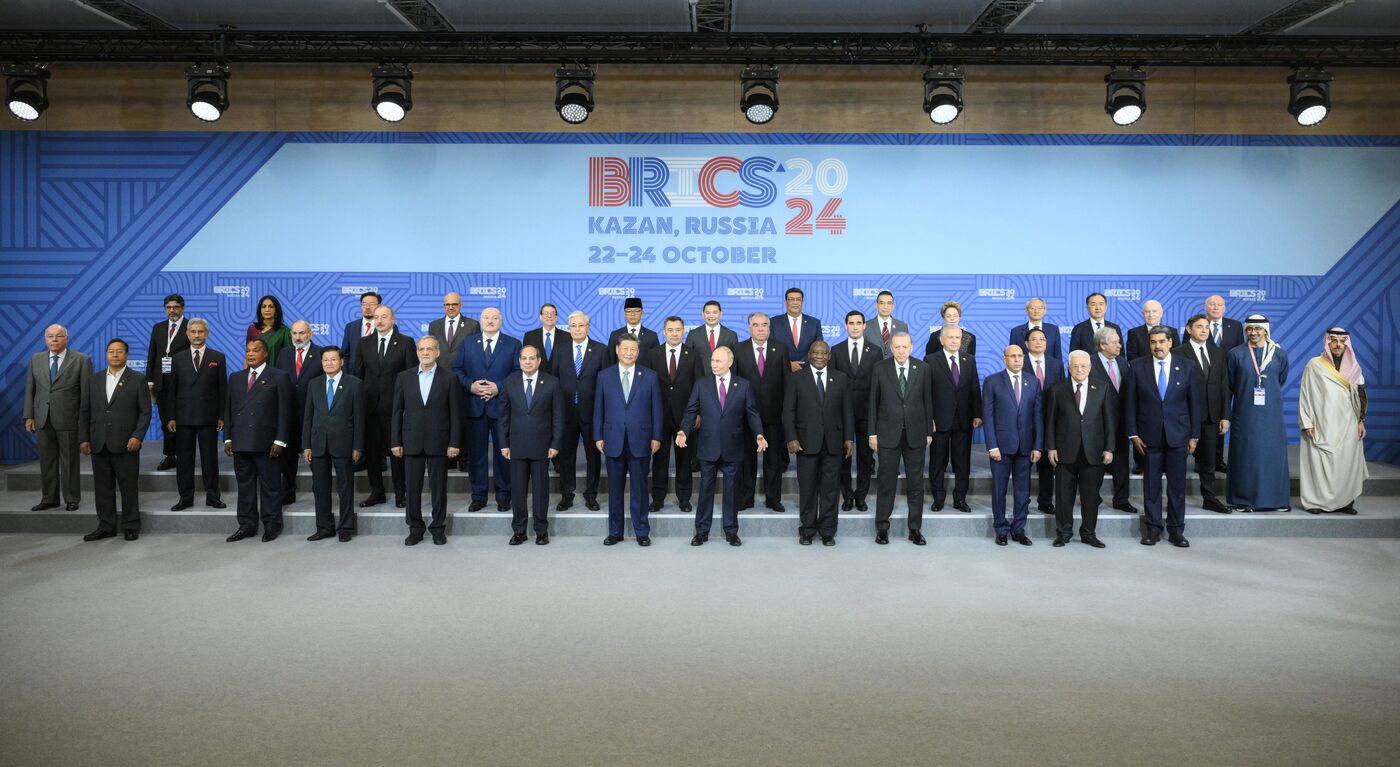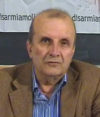BRICS 2024: Building a New World
BRICS, 4 Nov 2024
Manlio Dinucci | Global Research – TRANSCEND Media Service

The plenary session of the Outreach/BRICS Plus meeting.
(By Alexei Danichev / Photohost agency brics-russia2024.ru)
28 Oct 2024 – The 16th BRICS Summit, chaired by Russia and held in Kazan, capital of the Republic of Tatarstan, was attended by 35 countries and six international organisations. The acronym BRICS comes from the initials of the group’s five founding members: Brazil, Russia, India, China and South Africa.
In 2024, Egypt, Ethiopia, Iran, Saudi Arabia and the United Arab Emirates joined BRICS, which became BRICS+’BRICS PLUS’. By the time of the 16th Forum, some 30 countries – including Algeria, Bangladesh, Bahrain, Venezuela, Pakistan, Malaysia, Azerbaijan and Turkey – had applied for membership.
The 10 BRICS + countries account for more than 46% of the world’s population, in fact about half considering their high population growth rate. By comparison, the G7 (US, Canada, UK, Germany, France, Italy, Japan) represent less than 10% of the world’s population. In 1992, the combined GDP of the G7 countries accounted for more than 45% of world GDP, while the combined GDP of the five countries that would later join the BRICS (in 2009-2011) accounted for 16%. By 2023, BRICS’ share exceeds 35%, while G7’s falls to 29%. The gap will continue to widen. By the end of 2024, the BRICS are expected to grow by 4% on average, higher than the G7’s 1.7%. The BRICS account for about a quarter of global merchandise exports and some dominate key markets such as energy resources, metals and food.

President of China Xi Jinping, center left, and President of Russia Vladimir Putin during a group photo ceremony for the BRICS leaders during the 16th BRICS Summit.
(By Sergey Bobylev / Source: Photo host agency brics-russia2024.ru)
The New Development Bank is becoming a major investor in the largest technology and infrastructure projects in the BRICS region. In this region, where the dollar and the euro used to dominate international transactions, the share of national currencies has risen to 65%. The share of the dollar and the euro has fallen below 30%.
At the same time, the BRICS are building a vast infrastructure network: the Northern Sea Route and North-South Transport Corridor, which Russia opened after NATO and the EU blocked transit routes to the West; the Russia-Mongolia-China Road and Rail Economic Corridor; the New Silk Road from China to Europe; and many others in Asia, Africa and Latin America.
“In Kazan,” President Putin said at the press conference at the end of the summit, “we reaffirmed that BRICS is not a closed format. It is open to all those who share its values. The members of the group are ready to work on common solutions without external impositions or attempts to impose narrow approaches on anyone. BRICS must respond to the growing demand for cooperation in the world. Accordingly, we have paid special attention to the issue of possible expanding BRICS by creating a new category called “Partner States”.
The Western view is diametrically opposed. Emblematic is the alarm expressed by the Foreign Policy Research Institute, an influential US think-tank:
“If the US does not act, the BRICS are likely to grow in strength, align their foreign policies against US interests, and have the potential to disrupt the global order that has so far averted major conflicts.”
______________________________________________
 Manlio Dinucci is a research associate of the Centre for Research on Globalization, a geographer, and geopolitical scientist. In the 1980s, he directed the magazine Lotta per la Pace (born from “Appeal against the installation of nuclear missiles in Italy”) and was Executive Director for Italy of the International Physicians for the Prevention of Nuclear War, winner of the 1985 Nobel Peace Prize. His latest books are L’arte della guerra/Annali della strategia USA/NATO 1990-2016, Zambon 2016; and Guerra Nucleare Il Giorno Prima, Zambon Editore; 2017.
Manlio Dinucci is a research associate of the Centre for Research on Globalization, a geographer, and geopolitical scientist. In the 1980s, he directed the magazine Lotta per la Pace (born from “Appeal against the installation of nuclear missiles in Italy”) and was Executive Director for Italy of the International Physicians for the Prevention of Nuclear War, winner of the 1985 Nobel Peace Prize. His latest books are L’arte della guerra/Annali della strategia USA/NATO 1990-2016, Zambon 2016; and Guerra Nucleare Il Giorno Prima, Zambon Editore; 2017.
This article was originally published in Italian on Grandangolo, Byoblu TV.
Go to Original – globalresearch.ca
Tags: BRICS, BRICS Central Bank, BRICS Currency, BRICS Network University, De-dollarization, Economics, Finance, International Trade
DISCLAIMER: The statements, views and opinions expressed in pieces republished here are solely those of the authors and do not necessarily represent those of TMS. In accordance with title 17 U.S.C. section 107, this material is distributed without profit to those who have expressed a prior interest in receiving the included information for research and educational purposes. TMS has no affiliation whatsoever with the originator of this article nor is TMS endorsed or sponsored by the originator. “GO TO ORIGINAL” links are provided as a convenience to our readers and allow for verification of authenticity. However, as originating pages are often updated by their originating host sites, the versions posted may not match the versions our readers view when clicking the “GO TO ORIGINAL” links. This site contains copyrighted material the use of which has not always been specifically authorized by the copyright owner. We are making such material available in our efforts to advance understanding of environmental, political, human rights, economic, democracy, scientific, and social justice issues, etc. We believe this constitutes a ‘fair use’ of any such copyrighted material as provided for in section 107 of the US Copyright Law. In accordance with Title 17 U.S.C. Section 107, the material on this site is distributed without profit to those who have expressed a prior interest in receiving the included information for research and educational purposes. For more information go to: http://www.law.cornell.edu/uscode/17/107.shtml. If you wish to use copyrighted material from this site for purposes of your own that go beyond ‘fair use’, you must obtain permission from the copyright owner.
Join the discussion!
We welcome debate and dissent, but personal — ad hominem — attacks (on authors, other users or any individual), abuse and defamatory language will not be tolerated. Nor will we tolerate attempts to deliberately disrupt discussions. We aim to maintain an inviting space to focus on intelligent interactions and debates.